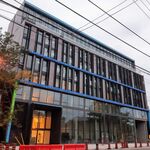What makes you think that the way SELRT is being built will handle that 50 years down the road? What's the solution if it does warrant its own fully separated ROW? We'll just put the line underground...Sure! At what cost in 50 years? They'll be thinking (rightfully so) that it should have been built that way in the first place.
The long/mid/short term aspect of this discussion is important and key -- but also quite subjective. And hasn't there been an assumption in this debate that chosen transit corridors start as low-capacity mixed-traffic and end up as heavy metros, with a possible intermediate stage as traffic-free surface routes?
What if Sheppard East never grew past surface LRT, and instead of gnashing teeth in 30 years over the choice the 'city fathers' made in 2011, they just built more surface LRT (or BRT)? Finch East xRT, Steeles East xRT, Lawrence, etc. Repeat as needed west of Yonge...
The obvious downside is the lack of a long-haul, rapid east-west route. (Actually I think an expanded Sheppard subway is a compromise if this is the aim -- couldn't the eventual cross-city demand justify S-bahn/RER speeds & stop spacing?) The upside is more mixed-traffic bus routes get upgraded to exclusive ROW. Development is fostered, although not on the scale that favours large developers but instead small-to-midsize property owners. Jane Jacobs dug that, and why not?
Remember the key planning argument in favour of the Sheppard stubway was to allow North York Centre to continue to develop. IIRC, the OMB would not approve more growth until transport capacity was increased to the Yonge/Sheppard node. Hence Mel's push for subway...
It seems to me there are various sliding scales we each prefer. Are we building for long-term or short-term or somewhere in the middle? High-capacity or mid-? Relative travel speed. Development potential. Each of these is a trade-off and requires compromises of our vision and who we think needs to be served when, where and how.
I'd say I'm short- to mid-term focused, on average, with long-term being a relative luxury that I compromise on because of the decades-long transit drought. I acknowledge the trade-off in favour of current riders at the expense of riders in mid-century and beyond.
In this continuum, I see the lean toward subway-building -- to the point of excluding surface rail in 416 -- as unwilling to short-change future citizens (a completely understandable position) but also inexplicably silent on the experience of contemporary riders who now ride in mixed traffic routes.
On speed and distance travelled, I'd say I've moved to the slower, shorter end of the spectrum -- also a shift from where I used to be. I weigh local travel as heavily as long-distance, and so tolerate the surface stop-spacing of TC.
I'm for more coverage of geographic area (with higher-order transit) compared to building subways fed by surface routes (that would likely be mixed traffic). Once again, not an absolute position but a place on a sliding scale.
On average I'm willing to sacrifice the weather-reliability and capacity of tunnels in favour of the fractional cost and timeliness of surface construction. "Subways are the only way to go" is too doctrinaire for me. (I wish we were building the
Red line and settled on BRT or LRT to Vaughan, but politics are how we plan.)
If there weren't political/financial and geographic realities to contend with, my uber-ideal might be a steady build of subways along with rapid construction of exclusive transit lanes -- esp. BRT -- on many, many major arterials in 416 and 905. But my take on the current reality forces a compromise to this vision.
ed d.




